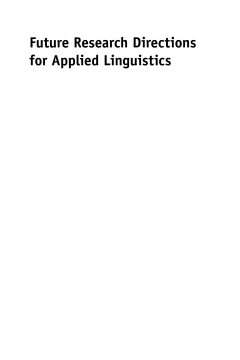
BOOK
Future Research Directions for Applied Linguistics
Simone E. Pfenninger | Dr. Judit Navracsics
(2017)
Additional Information
Book Details
Abstract
This edited volume provides an overview of current thinking and directions for further research in applied linguistics by bringing together in a single volume a range of perspectives regarding original research agendas and innovative methodological approaches. It focuses not only on the challenges that applied linguistics researchers have been facing in recent years but also on producing workable and productive research designs and on identifying ways of how alternatives to conventional research methodologies can be used. Discussions featured in the volume include the so-called ‘Bilingual Advantage’ in psycho- and neurolinguistics; the optimal starting age debate in foreign language learning; the growing interest among applied linguists in more nuanced and more complex (statistical) data analysis and the priority given to more descriptive and social approaches to linguistics rather than to theorising. The collection will be a useful reference and stimulus for students, researchers and professionals working in the areas of applied linguistics, psycholinguistics, second language acquisition and second language education.
This eclectic volume offers valuable insights on a range of applied linguistic issues, with a strong focus on research methodologies, including psychological, neurolinguistic, and dynamic systems modelling. It is refreshingly multinational, and presents studies on several less-researched languages. Directions for future research are highlighted on topics ranging from age to language policy, with a strong section on bilingualism.
This is a thought provoking, edited volume, which will appeal to and interest a wide variety of readership, from undergraduate students to scholars.
Jose Aguilar, Université de la Sorbonne Nouvelle - Paris III, France
This is a timely collection of chapters by well-known scholars, in which an innovative research agenda and approach to applied linguistics are proposed, emphasizing its multidisciplinary character. I believe it is essential reading for all who are interested in the most recent developments in understanding what applied linguistics is and where it is going.
It’s hard to predict the future in any domain but the contributors in the present volume are well placed to help shape research in applied linguistics, which makes their analyses, predictions and suggestions a rich source of inspiration for researchers around the world.
Simone E. Pfenninger is Assistant Professor of Psycholinguistics and Language Acquisition at the University of Salzburg, Austria. Her research interests include multilingualism, psycholinguistics and the age factor in SLA, especially in regard to quantitative approaches and statistical methods and techniques for language application in education.
Judit Navracsics is Professor of Linguistics at the University of Pannonia, Veszprém, Hungary. Her research interests are bi- and multilingual development in early childhood, the bilingual mental lexicon and bilingual processing.
This book puts together very important studies using various methods of
applied linguistics, including brain imaging and experimental studies in bilingualism/
multilingualism as well as studies on language ideology, language
acquisition, and language attrition.
Engin Arik, Purdue University, USA
Table of Contents
| Section Title | Page | Action | Price |
|---|---|---|---|
| Contents | v | ||
| Contributors | xi | ||
| 1 Introduction | 1 | ||
| Part 1 Future Implications for Bilingualism | 13 | ||
| 2 The Future of the Bilingual Advantage | 15 | ||
| 3 The Multilingual Brain: Implications for the Future | 33 | ||
| 4 Phonological and Semantic Awareness of Bilinguals and Second Language Learners: Potential Implications for Second Language Instruction | 53 | ||
| 5 Perception of Checked Vowels by Early and Late Dutch/English Bilinguals – Towards a New Measure of Language Dominance | 74 | ||
| Part 2 Future Implications for Second Language Acquisition and Language Policy: Theoretical Considerations | 99 | ||
| 6 Recent Advances in Quantitative Methods in Age-related Research | 101 | ||
| 7 Language Policy in Ukraine: The Burdens of the Past and the Possibilities of the Future | 120 | ||
| 8 The Reanalysis of -end as Marker for Gender-sensitive Language Use and What This Implies for the Future Expression of Gender Equality | 149 | ||
| 9 Analytic Framework of the Critical Classroom: Language and Beyond | 172 | ||
| 10 Strategies in Multilingual Learning: Opening New Research Avenues | 192 | ||
| Part 3 Future Implications for Instructed Second Language Acquisition: Empirical Evidence | 213 | ||
| 11 Academic Writing Development: A Complex, Dynamic Process | 215 | ||
| 12 Lessons Learned from the Integration of Findings from Identical and Semi-Cognate Visual and Auditory Processing in Bilingual Cognate Studies: Implications for Future Studies | 243 | ||
| 13 The Impact of Attitudes on Language Retention of Russian as a Foreign Language in Hungary: Some Lessons to be Learnt from Attrition Studies | 265 | ||
| 14 Concluding Thoughts: A Road Map for Future Research in Applied Linguistics | 286 | ||
| Index | 293 |
